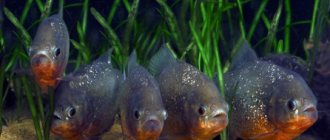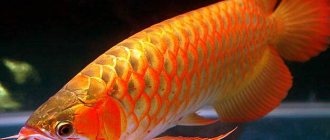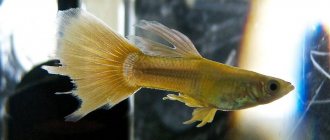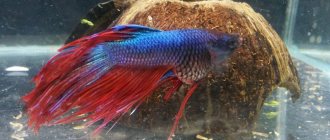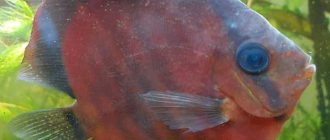You can often hear from pet store sellers that small and large catfish clean the water in the aquarium and the owner does not have to do this. Catfish, combing the soil at the bottom, actually pick up everything edible, partially cleaning the pollution. By the way, this does not mean that your pet’s nutrition should be left to chance.
It is also important to note that the natural habitat of these fish is silted water. But this also does not mean that you can not clean the aquarium at all and only change the water occasionally. Increased aeration of the water is really not necessary, and clean water and an aquarium are the key to the health of your fish. If you also have other fish, they simply need cleanliness, and the catfish will quickly get used to it and will not experience any inconvenience.
Guppies and Mollies
These fish are difficult to confuse with other species due to their bright colors and bushy caudal fin. The surname of the discoverer, Dr. Robert John Lechmere, Guppy gave such an unusual name for the fish. Their homeland is in Brazil and Venezuela, although they are also found on the islands of Trinidad and Barbados.
Guppies are able to survive even in the worst conditions, while reproducing profusely. Therefore, instead of worrying about creating the ideal environment, it is better to take care of the capacity of the aquarium.
Mollies are another native of freshwater bodies of South America. Mollies are very hardy and easy to care for fish. But they love her not for this, but for the incredible palette of colors of her scales.
Mollies are very hardy and easy to care for fish.
Like guppies, mollies reproduce quickly and in almost any conditions. It is worth considering that such fish grow up to 6-10 centimeters and they will need a lot of space, up to 80 liters.
The basis of the mollies diet is flakes and frozen worms.
Aquarium catfish fish
Extremely unpretentious aquarium catfish are very popular among aquarists, especially beginners. The fish constantly dig through the soil, picking up food that has not been eaten by other fish, and eating overgrown algae. For this reason, they are called aquarium cleaners or orderlies.
One of the oldest representatives of the aquarium armored genus are speckled catfish. There are numerous irregular spots on the fins and throughout the body. The multiple bony plates of the body overlap each other with their edges, forming a “shell”.
The high dorsal fin of males is extended upward and pointed, while that of females is rounded and shorter. The body is mainly grayish-olive in color, acquiring a metallic sheen on the gills and sides, the abdomen is yellowish. The mouth of catfish is located low, on the upper lip there are 2 pairs of short whiskers, used when searching for food.
Another common variety is aquarium fish, albino catfish, with red eyes and a pinkish-colored body. They interbreed and are no different in either reproduction or maintenance. The body length of males is 4 – 5, females – up to 8 cm. Life expectancy is more than 6 – 8 years.
Neon tetra
Neon tetras are small, high-energy aquarium fish. Their homeland is in South America. Aquarists love them due to their bright colors and interesting schooling habits. Neon tetras are ideal for creating a lively and natural aquarium.
Neon tetras are considered fairly easy to care for and can adapt to many types of conditions. Given its small size, the tetra will feel great even in a cramped aquarium.
Neon tetras are ideal for creating a lively and natural aquarium.
Compatibility with other aquarium inhabitants
Speckled corydoras are very peaceful fish and are compatible with almost any species, except large predatory representatives that can swallow them.
Compatibility table for Corydoras with other fish.
They get along well with neons, tetras, barbs, zebrafish, angelfish, livebearers, incl. guppy When fish of different species are adjacent, it is necessary to remember that corydoras prefer cool water , so you should not put them in the same aquarium with heat-loving individuals.
Cherry and tiger barb
Barbs themselves are social fish and get along well with other species. However, they can be a bit skittish in some cases, especially when surrounded by more aggressive fish.
There are two types of barbs with unusual colors that will decorate any aquarium:
- Cherry barb - lives in the South-West of Sri Lanka in the waters of Kelani and Nilwala.
- The tiger barb is an energetic fish known for its striped pattern. The place of origin of this species is Southeast Asia, the waters of Sumatra, Borneo, Thailand and Cambodia.
The cherry barb lives in the South-West of Sri Lanka in the waters of Kelani and Nilwala.
Barbs are very active fish and require a lot of space to move. They eat absolutely everything, so they can be fed a mixture of dry food and special frozen shrimp or moths. Considering their habitat, barbs are most comfortable living in aquariums densely overgrown with plants.
(Visited 149 times, 1 visits today)
Marine
Popular fish live in all oceans except the Arctic.
Zebrasoma
The range extends from Hawaii to Japan, in the Pacific Ocean. Mainly on reefs and lagoons. This is a deep yellow fish. Although other colors are also available. Hardy, lives up to 10 years. Needs bright lighting.
Moorish idol
The homeland of this exquisite fish is the waters of the Indian Ocean near the island of Mauritius. The appearance is very memorable. But the idol is very demanding about living conditions and requires specific nutrition. In captivity it grows up to 10 cm.
Angel fish
Lives in all the world's oceans. The main places where they can be found are coral reefs. They live in pairs. Sometimes a male has a small harem of 2–3 females. They have a bright neon color.
Clown fish
The habitat is very wide and extends from eastern Africa to Japan and Australia, in the waters of the Pacific and Indian Oceans. Most often, the color of the aquarium clown fish is rich orange with white stripes. Under natural conditions, for protection from predators, it lives among the tentacles of a stinging sea anemone plant.
Mandarin fish
The homeland of this colorful and very original-looking fish is the waters of the Pacific Ocean, in the area of the Philippine Islands and Australia. When maintaining a house, you need an aquarium of at least 300 liters, with corals planted in it.
Fish surgeon
The brightly colored surgeonfish with poisonous spines on its fins lives on reefs in the Pacific and Indian Oceans. Requires a tank of more than 1000 liters. And regular replacement of very clean water.
Sapphire Chrysiptera
In the wild it lives off the coast of Australia, New Guinea, and the Philippine Islands. The appearance vaguely resembles a sapphire, which is where the name comes from. Grows up to 9 cm. An aggressive fish that needs an aquarium of over 300 liters.
Blacktip reef shark
This representative of sharks lives in the tropical waters of all oceans. Mainly concentrated near reefs. They can even swim into fresh waters of rivers flowing into the sea. It is not dangerous to humans, although it sometimes displays aggression. Requires a large tank of 3 tons.
Brocade pterygoplicht
Brocade pterygoplicht is a luxurious, handsome catfish. The homeland of the fish is the Orinoco River. It got its name thanks to a kind of brocade - evenly scattered black or dark brown spots. It has a large, magnificent dorsal fin that is shaped like a sail. The mouth is a large sucker. Recently it has become popular among aquarists. Grows up to 30-35 centimeters. It must be taken into account that if the Brocade Pterygoplicht is kept together with large, clumsy and slow fish, it will try to attach itself to them, as a result the scales may be damaged. He's probably attracted to mucus. Basically, this is a very peaceful fish; it gets along with small species without problems.
Dimensions
Judging by historical references and descriptions of contemporaries of past centuries, catfish in ancient times reached a length of 5 meters and weighed up to 400 kg, which was mentioned in the works of the scientist and fisherman Leonid Pavlovich Sabaneev. According to official data, the largest catfish measured over 3 meters and weighed 306 kg. This catfish was 80 years old. (the largest fish in Russia) Nowadays, you can still come across catfish weighing 100 kilograms or more, but quite rarely, although not long ago a specimen measuring two and a half meters in size and weighing 150 kg was recorded. Individuals weighing 30-50 kg are considered relatively common prey for Volga catfish, especially in the Volga delta.
Diseases
Catfish are susceptible to bacterial and fungal diseases. The reasons for their appearance may be:
- sudden changes in water temperature in the aquarium;
- the presence of salt in the water, which is poison for them;
- a high concentration of nitrates, which leads to the death of the antennae, which is equivalent to the death of the individual.
When a disease occurs, the behavior of the fish changes - it becomes inactive and lethargic, refuses to eat, and a white coating may appear. If such signs are observed, it is necessary to immediately isolate the catfish in a separate container and begin treatment with medications and vitamins.
Synodontis
Synodontis is an African catfish. The homeland of the fish is the reservoirs of the Congo River. Synodontis are often called skinwalkers because they turn belly up and swim on the surface, collecting prey with their fluffy antennae. This catfish has a lot of color options, whose homeland has made it “invisible” in the aquarium. Its spotted color and various shades of colors make it, despite its rather large size, invisible at the bottom of the aquarium, and you need to spend a lot of time to find it. The fish feels unprotected if there is not enough shelter in the water.
Catching catfish
Catching catfish using kwok
There are many different types of catfishing
. Among them, the most famous are catching catfish with a quok, a spinning rod, a donka, a float rod and a number of others. Nowadays, catching catfish with a quok has become less successful and is rarely used, although there are remote corners where they still catch with a quok, for example, in some tributaries and channels of the Pripyat. The most common fishing is with bottom rods. On lakes they sometimes catch fish in circles. Increasingly, catfish are becoming prey for spinners, and catfish up to 3 kg are caught on float rods when fishing with a crawler, a spindle and a bunch of worms, as well as with crayfish and bivalve shells. Fishing for catfish begins before spawning - when the flood level drops and the water becomes clearer. At this time they are caught all day. In summer, catfish bites occur more often after sunset - all night until sunrise. Catfish can be caught during the day, but the larger the catfish, the more careful it is and hunts only in the dark. Particularly large ones are found on clear, moonlit nights and during thunderstorms, when they rise to the surface. At the beginning of summer (before spawning) they are caught at a depth of 1–2 m in bays, creeks, and on shallows adjacent to the riverbed. In summer, after spawning, near steep banks, at depths near the exits of holes, at the end of pools, near the shores under overhanging bushes and trees.
A bottom fishing rod for catching catfish should be especially durable. Scaffolds are 0.7–1.0 mm in diameter. One or two leashes 0.4 m long and 0.6–0.8 mm in diameter, but soft leashes made of woven nylon or silk are preferable. Hard leashes alarm catfish. Hooks with a long shank No. 10–16, according to the bait, tees are often used. The sinker is heavy, sliding, weighing up to 100 g. The leashes are connected to the line with carabiners. After casting, the line is tied to a firmly driven stake, tree trunk or bush. As bait in the spring, a bunch of large worms, crawlers, as well as live bait, leucorrhoea, gudgeon and loach, are used. Catfish take better bait with large live bait, weighing 200–300 g. Particularly long casts will not bring success, the catfish goes near the coast, do not forget about this. In summer, the range of baits expands; in addition to those already mentioned, they use a spindle, a bunch of bivalve shells, a mole cricket, locusts, large seals - rhinoceros beetle larvae, and a black leech. Particularly popular are various birds whose plumage is scorched in the fire. Indeed, the smell of burnt cornea irresistibly attracts catfish, so fishermen sometimes resort to cunning. A small piece of burnt felt, hoof, horn or felt is placed on the hook, and then a crawl, a bunch of worms, etc.
The catfish bite is very sharp, which often leads to self-hatching. Sometimes it is first expressed in the weakening or tension of the line, but then frequent and strong jerks follow one after another. In all cases, a vigorous hook is used so that the hook penetrates deeper into the mouth, and fishing begins. Feeling pain and danger, the catfish often “lies down” - goes behind a driftwood, boulder, snag and does not move. However, it is worth placing a plank or stick on the stretched line and tapping it with a hard object, while simultaneously tugging on the stretched line, and the catfish will go into action. The catfish must be led persistently, pulling it to the shallows, where it can be stunned, stained under the bottom of its mouth, and pulled out away from the water. Medium and small catfish can be caught with a landing net. You need to be attentive and careful, do not allow the catfish to jerk on the extremely stretched tackle, and hand over the supply on time. Do not wrap the line around your hand, so as not to cut it to the bone; you should be careful not to get your foot into the loop of the line on the ground.
Fishing with a spinning rod can be especially successful on lakes in the pre-spawning period, but a slow retrieve of a large spoon or tackle with a large fish (150–250 g) is necessary. Fishing is also successful on a number of rivers that quickly clear of turbidity. However, the most successful catfishing occurs in the summer, with the beginning of the hot season, continuing until the beginning of the autumn coloring of the leaves. Captures are especially frequent on thunderstorm days and nights. The spoon should be driven at a slightly slower pace past individual clumps of algae, boulders, driftwood and snags, trying to ensure that it passes no further than 0.5 m from them. In daylight, the spoon should pass near the bottom, and in twilight - higher. You need to make at least a dozen runs past suitable shelters - the catfish doesn’t always take it on the first cast. A catfish bite feels like a hook, the hook should follow immediately. To equip a spinning rod, fishing line with a diameter of 0.5–0.6 mm is used. A leash is not used. The reel makes fighting fish very easy.
Reproduction of individuals
Reproduction of speckled corydoras sometimes happens in the aquarium itself, but it is preferable to place several individuals in a separate container for this. The aquarium for spawning should be no less than 15-20 liters of water, and there should be driftwood, stones and low-growing plants at the bottom. Usually one female and several males are placed there. You can distinguish a female from a male by the larger size of the female and her rounded abdomen; the males have a larger dorsal fin than the female and a sharper shape. Males are much brighter in color.
External differences between a male and a female Corydoras.
A few days before the planned breeding, individuals of different sexes should be separated from each other and fed intensively. The female's readiness to spawn is indicated by her reddened abdomen. After this, the fish are placed in a common container, this is done in the evening, a little cool water is added, and spawning begins with the first rays of the sun.
A decrease in water temperature in a container is associated by fish with the onset of rains in natural conditions and stimulates the onset of spawning.
Reproduction occurs as follows. The female swallows milk and lays eggs in the ventral fin area. Then she finds a secluded place where she attaches the eggs to a place lubricated with milk. The fertility of female corydoras is quite high, reaching 200-250 eggs. After spawning is completed, females and males are removed from the aquarium, otherwise they may destroy the eggs.
Newborn speckled catfish fry do not immediately become like their parents.
The eggs develop within 5 days. At this time, the water temperature in the aquarium should be higher than usual - within 27-28ºС. This speeds up the ripening process and also protects against diseases. The fry are fed with food for adults. By the age of one month, the fry have grown to a size of 1 cm. The age at which spawning is possible begins at 8 months.
Ancistrus
Ancistrus is a very original catfish, the birthplace of the fish is Brazil. Male ancistrus have specific bushy, leathery appendages on their heads, which is very popular with children who watch these fish in the aquarium. The body is generally dark gray in color, with light spots. But the color may “fade”; in Ancistrus it is changeable. Often fish stick to the glass of the aquarium and scrape off algae. The homeland of the aquarium catfish is the Amazon River, where the habitat is soft, slightly acidic water. But the fish easily adapts to life in hard water, which must be purified and oxygenated.
